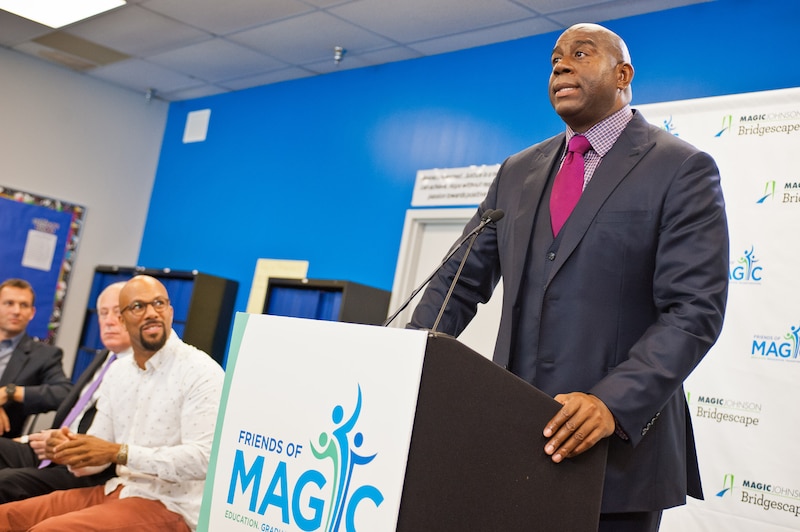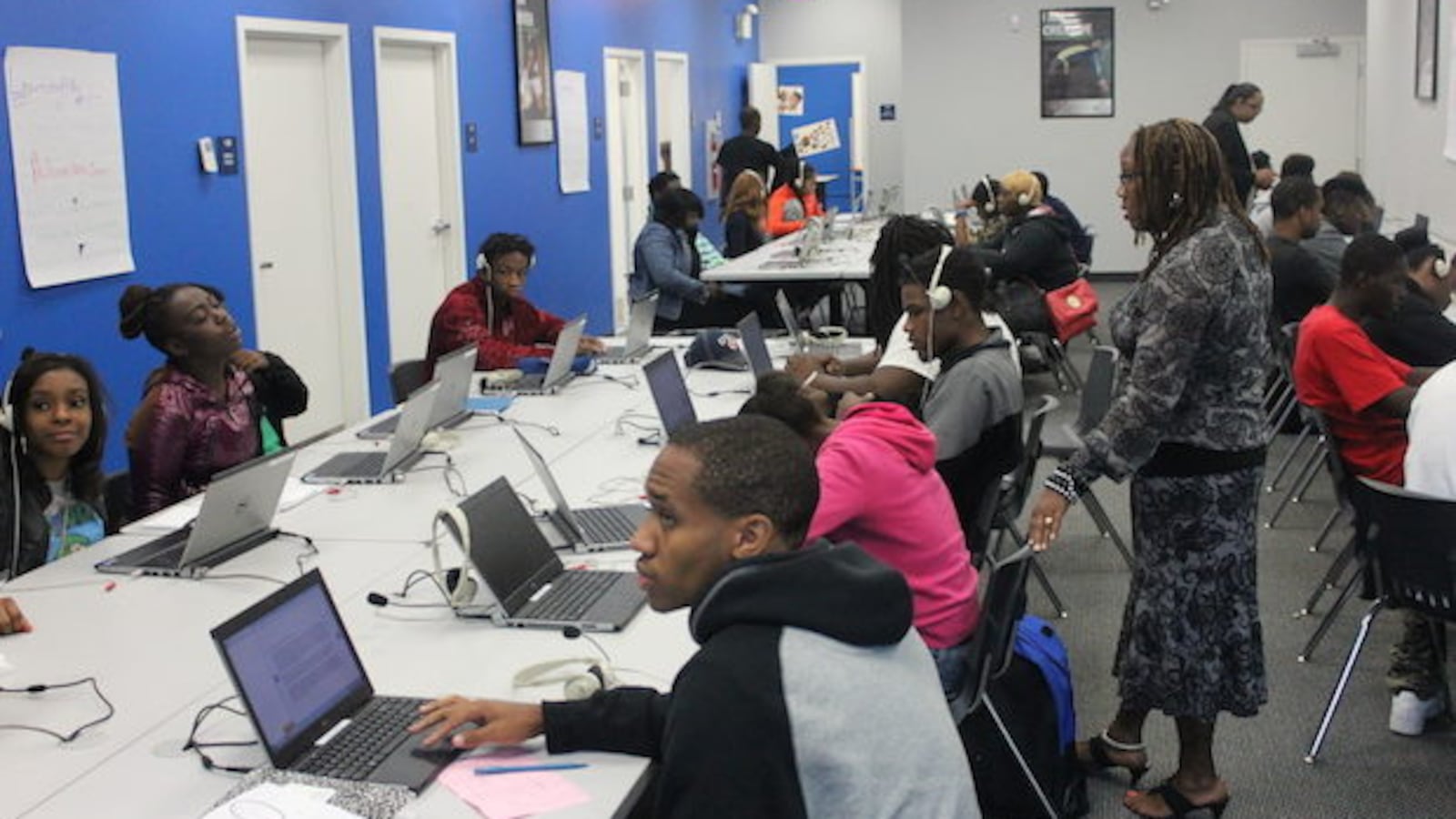CHICAGO — Six years ago, Chicago opened several new alternative schools aimed at serving students who had dropped out of high school but were eager for another shot at a diploma.
The country’s third-largest school district had previously relied on alternative schools run mostly by a nonprofit with deep community ties. But the new schools were run by out-of-town operators, including for-profit companies that leaned heavily on an online curriculum.
For years, advocates and journalists have raised questions about the quality and business practices of these high schools, documenting students left to Google answers to tests and the schools’ aggressive marketing tactics. Earlier this year, a scathing review by district officials of one provider, EdisonLearning, concluded that students weren’t receiving enough in-person instruction and that its online curriculum offered mostly low-level tasks. One district reviewer balked at what Edison charged its schools to use its own software, calling the setup a “money factory.”
Over the last few months, Chicago has shut down all four of EdisonLearning’s schools.
“Displacing children is not in their best interest,” Chicago’s schools chief, Janice Jackson, told the school board in July. “In this case, the district has acted on a provider who failed to provide a quality education for our children.”
Chalkbeat obtained the 2019 district review, and a letter Chicago sent to EdisonLearning in July echoing similar concerns, through a public records request. EdisonLearning disputed the claims that its students weren’t receiving direct instruction and that its curriculum was too easy in a May letter to Chicago officials, going as far as accusing Chicago’s reviewers of “malfeasance.” The company implied it had been singled out — noting that another for-profit operator passed the district’s review — and argued that its scores had “no basis in fact or reality.”
But the closures are one in a long series of setbacks for the Florida-based company, previously known as Edison Schools, which has seen most of its Bridgescape schools close across the country in recent years. In Chicago, the closures displaced hundreds of students, illustrating one of the pitfalls of using this model to educate some of the city’s most vulnerable students.
Still, researchers who track enrollment at schools that use a mix of in-person and computer-based instruction say enrollment has continued to grow nationally — in part because districts are eager to see graduation rates rise.
“Year after year, there is very little movement in terms of policy, and very little in the way of accountability mechanisms being put in place,” Alex Molnar, a research professor at the University of Colorado Boulder, said of virtual and blended learning schools. Molnar co-founded the National Education Policy Center, which issues an annual report on the schools and generally has been critical of for-profit operators in education.
Issues with their curriculum and teaching practices have persisted, he said, in part because states and school districts lack the money and manpower to properly oversee the many vendors who run these schools or provide them with a curriculum. The result: “chaos and continual churn,” Molnar said.
***
When EdisonLearning landed its Chicago contract in early 2013, officials were looking for ways to raise the city’s five-year high school graduation rate, which stood near 62%. Today it’s nearly 79%.
One of several moves the city made over that period was to expand so-called dropout recovery programs. “Doubling the number of quality options and alternative pathways to nontraditional learning environments allows us to help our hardest to reach children and provide them a chance to succeed,” Chicago’s schools chief Barbara Byrd-Bennett said in 2013.
Around the same time, Edison was expanding its work across the country with dropouts and students at risk of dropping out. It packaged its model as “Bridgescape,” a half-day, mostly online program for students who’d fallen behind. In 2012, Edison signed a marketing deal with basketball star Magic Johnson, who lent his name to the Bridgescape schools for a time to help attract students.

By 2015, there were 17 Bridgescape schools across five states, according to company documents shared with a Florida school board. With the Chicago schools closed, Edison says just two remain, both in Ohio. (Edison still operates six full-day alternative high schools in Florida, and is slated to open four more there next year.)
In Illinois, only a nonprofit can open a charter school, though charter schools can contract daily operations out to for-profit companies. But the state does allow for-profit companies to open alternative schools set up as “programs.” That’s how the Bridgescape schools operated in Chicago, though students experienced them as schools, operating in their own buildings with their own staff.
Comments made at Chicago’s July school board meeting, and the 2019 district review, indicate that the city has changed its stance on how much computer-based instruction is the right amount for students who have fallen behind. At the same meeting, at least one school board member raised concerns about whether for-profit providers should be used to run these alternative schools at all.
“Graduation was the desired goal previously,” Hal Woods, the Chicago school official who oversees these alternative high schools, told the board. “We have changed in terms of far more emphasis on social-emotional learning, particularly with this subset of students, and also with regard to actually having a concrete post-secondary plan after graduation.”
Many alternative high schools nationwide rely on online programs that identify skills gaps and allow students to make up the specific credits they are missing. In Chicago, EdisonLearning said it used “a strong and rigorous curriculum” featuring both direct and online instruction. More than 1,500 Chicago Bridgescape students earned diplomas over five years, Edison said last year, and it’s likely that most of those students wouldn’t have otherwise graduated.
Several officials who conducted the 2019 district review, though, said it appeared students spent too much time on a computer with unclear benefits — concerns raised about Edison’s schools elsewhere.
Staff members “question whether students are truly learning the standards from the online courses,” notes a 2017 review of the Bridgescape program in Norfolk, Virginia. Norfolk ended its contract that year, as Durham, North Carolina and Bridgeton, New Jersey, did in 2016. (In Norfolk, Edison says responsibility lies with the district, which staffed the program. Edison says all three of these contracts came to an end because of district “funding reductions.”)
Edison isn’t alone: The district reviewers, who Chicago says frequently visited alternative schools, also criticized the two operators that did make the cut for relying too heavily on their online curriculums. Such concerns have dogged other programs designed to help students catch up, which are often packaged as in-school “credit recovery” rather than separate alternative high schools.
Edison’s cost structure has raised particular questions in Ohio and Chicago. In its Chicago Bridgescape schools, Edison budgeted $1,200 out of the $8,000 it spent per student on its own software, records show. Meanwhile, the staffing plan Edison submitted to Chicago showed the company had cut or left unfilled nearly 40% of its positions last school year, including many teachers, social workers, and college and career counselors.
“This software takes money away from spending on classroom teachers and face-to-face time and drives down funding for adults in the building,” a Chicago schools official told Edison in the May letter.
Michael Serpe, a spokesperson for EdisonLearning, said it’s common practice for vendors that create online curriculum to use those materials in schools they also oversee. Edison was still meeting the district’s minimum staffing requirements, and would have continued to do so had its contract been renewed, he said.
Elsewhere, researchers have found that hands-on, often labor-intensive support from adults seems to be key to keeping alternative school students on track to graduation.
Researchers Kathryn Hill and Zitsi Mirakhur interviewed students and educators in New York City’s alternative high schools for a 2018 report. They found that a handful of schools that successfully graduated struggling students had staff who paid close attention to students’ home lives and attendance records, and relied heavily on extra staff from community partners.
“Having adults who are looking out for these students seems to be really important to this work,” Mirakhur said.
***
For EdisonLearning, Chicago’s review followed other recent troubles. A 2017 ProPublica investigation found that in Ohio, Edison received payment for Bridgescape students who never showed up to class. In Chicago, the city’s NPR affiliate WBEZ reported that Bridgescape schools and other alternative schools lost $1.8 million in funding because many of their students were not coming to class. (Edison told those news outlets that extended absences were a “persistent challenge” and attendance was low because the schools served a “costly, time-consuming, extremely difficult population.”)
After Chicago decided to pay these schools based on average daily attendance instead of overall enrollment, Edison shuttered a Bridgescape school in Englewood, one of Chicago’s most disadvantaged African-American communities. It caused “a massive displacement for students,” said Woods, the Chicago official who oversees most alternative schools.
Now, that is happening again.
Some 420 students were enrolled in Chicago’s Bridgescape schools when they closed, most of whom were African-American and from low-income families. Woods, the school official, said that since some students graduated over the summer and others had stopped attending, about 330 students would need to find new schools.
The city made efforts to help. Each Bridgescape student was assigned a member of a special district team set up to help the students choose new alternative high schools. The district called and met with displaced students, including at their homes. The district also offered former Bridgescape students spots in a six-week summer program that included mentoring, counseling, and pay for a community service project.
Still, it’s unclear where most of those students ended up. The two new alternative schools that Bridgescape students were encouraged to attend now enroll just 100 students, though the district said it expects their enrollment to grow over the school year.
Even Serpe, the Edison spokesperson, described the sudden closures and their effect on students as “an absolute circus.” But it’s not unusual for the company to lose a contract when a new mayor, schools chief, or school board comes in, he said. In Chicago, all three have changed since Edison won its contract in 2013.
“We’re a vendor,” Serpe said. When the company’s relationship with a school district ends, “we move on and go somewhere else.”
Left figuring out what’s next is 18-year-old Kayla Misher, who attended a Bridgescape school in the Brainerd neighborhood on the city’s South Side. She liked the teachers’ “hold-your-hand, but also let-you-guide-yourself” approach, and saw the school as her “way to getting away.”
“Now that it’s closed down, it’s going to be hard for me to learn with other teachers, because I was so used to how they teach me,” she said.
It wasn’t the first time Kayla’s school had closed. When she was 11, the city shut down her neighborhood elementary school for low performance, scattering her classmates across the city.
That building is now home to an alternative high school run by Camelot, another for-profit operator. Its curriculum relies less on online lessons, and it recently stepped up the social and emotional support it offers students. But Camelot is being overseen by an independent monitor after the school district’s inspector general determined the company manipulated Chicago’s contracting process and got improper access to former schools chief Byrd-Bennett — who’s now serving time in federal prison for her role in a separate bribery scheme.
It’s where Kayla is attending high school this year.


